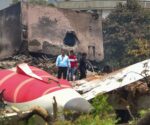Tourists given ‘significant danger’ Easter alert with Sahara dust to descend on hotspot | World | News
Spain has barely had time to recover from one of its wettest Marches on record, as the settled and warm weather will again be replaced by a new cold front and intense storm. Storm Olivier is set to hit Spain, Portugal and the Canary Islands on Wednesday (April 9).
The Spanish state meteorological agency (Aemet) has issued a warning about its potential consequences, as heavy and persistent rainfall with strong storms is expected. Experts have issued orange warnings for heavy rain and storms in the archipelago for Wednesday and Thursday. The agency warned in a video by spokesperson Rubén del Campo: “The danger is significant. Stay away from ravines even if they are dry.”
“The first few days of Easter 2025 are shaping up to be unstable due to the presence of Storm Olivier, which will bring heavy rain to the Canary Islands before then.
“This will bring a rainy first weekend of Easter to many areas of our country, especially in the south and west.”
According to Rubén del Campo’s forecast, the first festive days “will be cool” and “rainy” across much of the country: “Temperatures are going to drop, and there will also be rain in much of the Peninsula,” noted Aemet’s spokesperson.
But this is not the only adverse weather Spaniards and tourists to the top European country will have to contend with.
According to Aemet, the provinces most affected by this new front of rain could be Cáceres, Ávila, Badajoz and some points in Huelva, Seville and Cádiz, where Saharan dust might also descend.
According to meteorological experts at Meteo365, “Starting Thursday, Andalucia will experience calima, an intense Saharan Dust storm. Mixed with the rain forecast, there’s a chance of heavy dirty rain. Our current hourly forecast is updated four times a day.”
Western regions of Andalusia appear to be most exposed as a mass of dirty air moves in through Cadiz and Seville, before settling inland.
Residents and tourists with hire cars have been advised to get the hoses out once the orange skies disappear, as this so-called “blood rain” causes chaos when it coats cars, windows and buildings in a stubborn layer of dust that’s difficult to remove.
It also worsens air quality, triggering health warnings for vulnerable groups and those with respiratory conditions.
For the rest of Holy Week, while the exact forecast is not yet known, evetyhing appears to be pointing towards unstable weather: “From Maundy Thursday onwards it is difficult to make a reliable forecast yet but it is likely that there is a higher chance of rain further north on the peninsula while southern areas may have less chance of precipitation. This needs further confirmation,” stated Aemet’s meteorologist.









